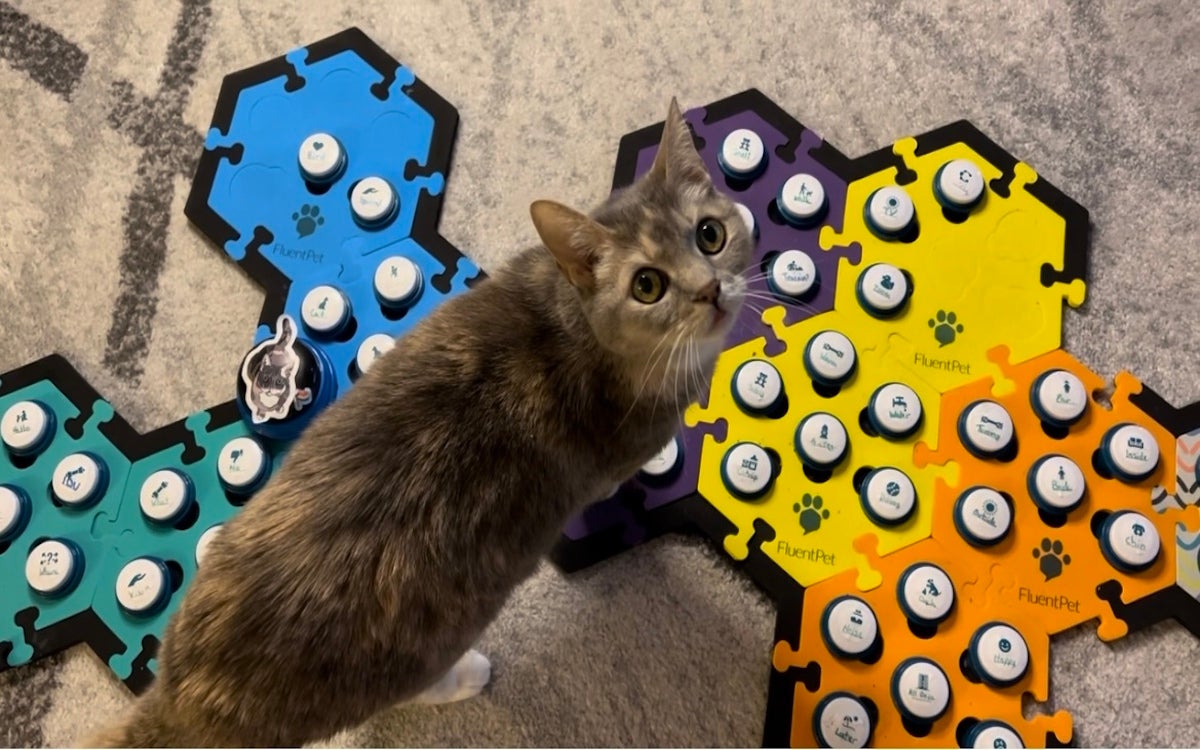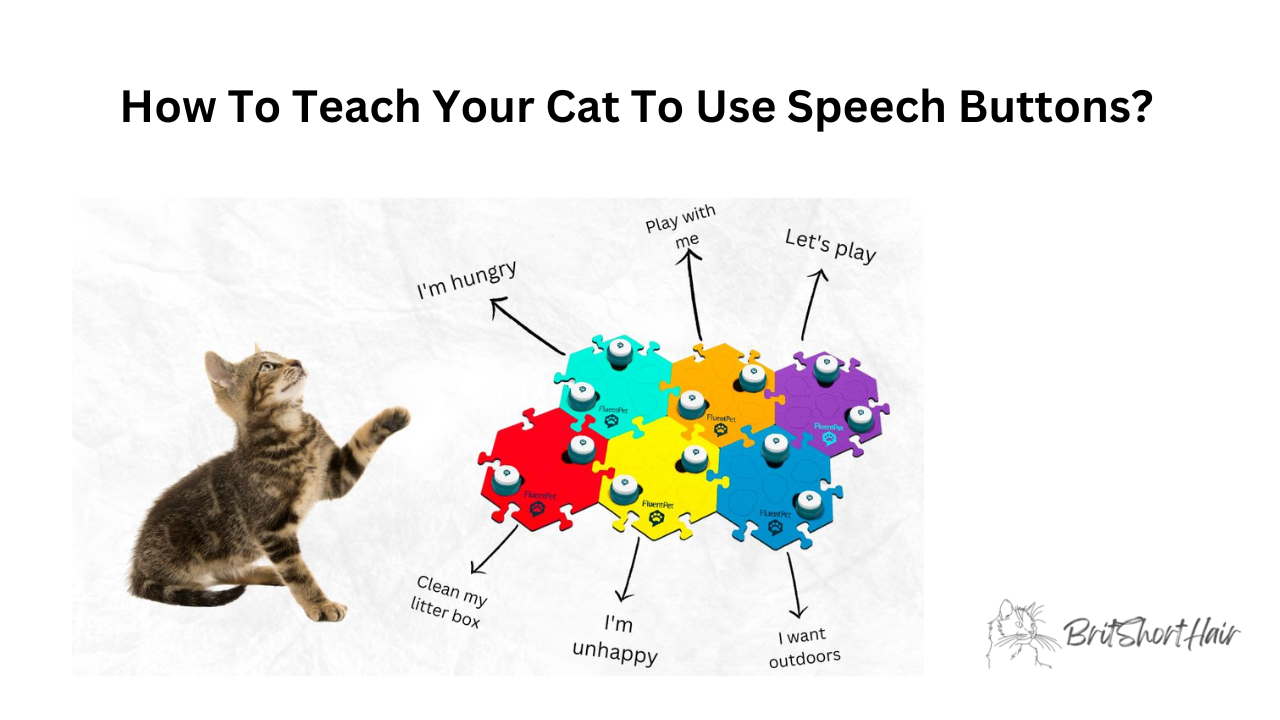Introduction

Do you wonder why cats need to communicate through speech buttons? We all understand the importance of communication in our relationships, especially with our feline companions. Although cats cannot communicate in our language, there is a fascinating new technique to cat communication that employs speech buttons. These buttons allow cats to express themselves in novel ways, communicating their needs, desires, and emotions. In this post, we’ll go into the intriguing process of teaching your cat to use voice buttons, allowing you and your feline buddy to engage in interactive communication.
Understanding Speech Buttons
Speech buttons have revolutionized the way we communicate with our feline friends. These clever buttons, when pressed, emit pre-recorded words or phrases. By assigning meanings to each button, cats can quickly grasp the concept and use them to express their intentions. It’s an incredible way for cats to bridge the communication gap and let us know what they’re thinking or feeling.
Benefits of Speech Buttons
Enhanced Communication
Speech buttons provide an extraordinary way for cats to convey their needs and wishes, strengthening the link between cats and their human carers. Cats may express themselves more effectively with the use of these buttons, resulting in a better understanding and closer bond. It’s a fantastic tool for bringing us closer to our feline companions and meeting their needs in a more meaningful way.
Mental Stimulation
Teaching cats to use speech buttons is not only a means of communication but also a mental exercise that engages their cognitive abilities. It stimulates their minds and provides them with mental enrichment, keeping their curious and intelligent nature engaged. By learning to interact with the buttons, cats are challenged and stimulated, which contributes to their overall well-being and happiness.
Bond Strengthening
Speech buttons provide an extraordinary way for cats to convey their needs and wishes, strengthening the link between cats and their human carers. Cats may express themselves more effectively with the use of these buttons, resulting in a better understanding and closer bond. It’s a fantastic tool for bringing us closer to our feline companions and meeting their needs in a more meaningful way.
Selecting and Introducing Speech Buttons
Button Selection
When selecting speech buttons for your cat, it’s important to consider their durability, ease of use, and clear audio playback. Look for buttons that can withstand your cat’s pawing and pressing without breaking easily. Additionally, choose buttons that have a distinct and audible sound when pressed, making it easier for your cat to understand and associate with specific meanings. Removable labels are a great feature as they allow you to customize the buttons according to your cat’s unique vocabulary or preferences.
Start with Basic Needs
To introduce speech buttons to your cat, start with a few basic needs such as “food,” “water,” or “play.” Choose buttons that represent these needs and label them clearly and concisely. For example, label one button as “food,” another as “water,” and a third one as “play.” By keeping the labels simple and easy to understand, you can help your cat associate the buttons with their respective needs more effectively.
Associating Words with Actions
Whenever you perform a specific action, like filling the food bowl or providing water, press the corresponding speech button and say the associated word aloud in a clear and distinct manner. For example, when you fill the food bowl, press the “food” button and say “food” out loud. This repetitive action helps your cat understand the connection between the action and the word, reinforcing their understanding of the speech buttons.
Training Process
Positive Reinforcement
Positive reinforcement is an essential aspect of training your cat to use speech buttons effectively. Whenever your cat engages with the buttons correctly, reward them with treats, praise, or affection. This positive feedback helps reinforce their understanding and encourages them to continue using the buttons to communicate. Celebrate their progress and make the training experience enjoyable for both you and your cat.
Start Simple
Start by focusing on one button and its associated action. Whenever you perform the action, gently guide your cat’s paw to press the button. Be patient and repeat this process consistently to reinforce the association between the action and the button. Over time, your cat will begin to understand the connection and learn to press the button on their own. Encourage and praise them for their efforts during the training sessions.
Encourage Exploration
Find a suitable spot for the speech buttons where your cat can easily reach them. Let them freely explore the buttons and their surroundings. Make the buttons visually appealing by adding colorful stickers or placing them in an attractive container. You can also entice your cat by placing treats nearby. When your cat shows interest in the buttons and interacts with them on their own, reward their efforts with positive reinforcement. This can be in the form of treats, praise, or affection. By providing positive reinforcement, you’ll encourage your cat to continue using the buttons and strengthen their communication skills.
Progress Gradually
As your cat gets the hang of using one speech button, you can gradually introduce more buttons for different needs. Take the time to associate each action with its corresponding word and reinforce your cat’s correct usage of the buttons. Remember, consistency and patience are key during this phase of training. Be sure to provide clear and consistent cues to help your cat understand the purpose of each button. With practice and repetition, your cat will become more proficient in using the speech buttons to communicate their needs effectively.
Reinforcement and Expansion
Consistent Use
Make it a habit to incorporate the use of speech buttons in your daily interactions with your cat. Consistency is key, so encourage family members or frequent visitors to also engage with the buttons. This reinforces their importance and helps your cat understand that they can use the buttons to communicate with anyone in the household.
Expanded Vocabulary
Once your cat has mastered the initial buttons, you can expand its vocabulary by introducing new buttons for additional needs or desires. For instance, you can introduce buttons for “outside,” “cuddle,” or “treat.” The training process for each new button remains the same: associate the action with the word, provide positive reinforcement, and be patient as your cat learns to use the new button.
Observing and Responding
Pay close attention to how your cat uses the buttons and respond accordingly. If you notice that they consistently press a specific button, take the time to assess their needs and provide the appropriate response. This not only shows that you are actively listening and understanding their communication but also helps build trust between you and your cat. Validating their efforts to communicate through the buttons reinforces their confidence in using this unique form of communication.
Patience and Adaptability
Individual Learning Pace
Keep in mind that every cat learns at their own pace. Some may catch on quickly to using the speech buttons, while others may require more time and repetition. It’s important to be patient, and encouraging, and provide consistent positive reinforcement throughout the training process. Celebrate even the smallest progress and keep supporting your cat’s efforts. With time and perseverance, they will continue to learn and communicate effectively through the speech buttons.
Adapt to Your Cat’s Preferences
Take the time to observe your cat’s preferred learning style and adjust your training techniques accordingly. Each cat is unique, and some may respond better to visual cues, while others may rely more on auditory associations. Pay attention to their reactions and adapt the training to suit their individual preferences. This personalized approach will help create a more effective and enjoyable learning experience for your cat, strengthening your bond along the way.
Conclusion

In conclusion, each cat learns differently while training. Cats may prefer aural or visual signals. During training sessions, you can learn which stimuli your cat responds to best.
If your cat is visual, use hand signs or gestures in your training. For instance, a hand motion can suggest a desired activity. If your cat responds better to aural signals, apply clear and consistent vocal orders.
You may improve your cat’s understanding and engagement in training by matching their learning style. This personalized method improves learning and increases your bond with your pet.
Train with patience, consistency, and positivity. Reward your cat for good behavior with goodies, praise, or playing. Understanding and working with your cat’s learning style will make training sessions more fun and rewarding for both of you.
hey we have a lot of information on cats you can check out by clicking Bristhorthair.com
wants to follow us on social media

